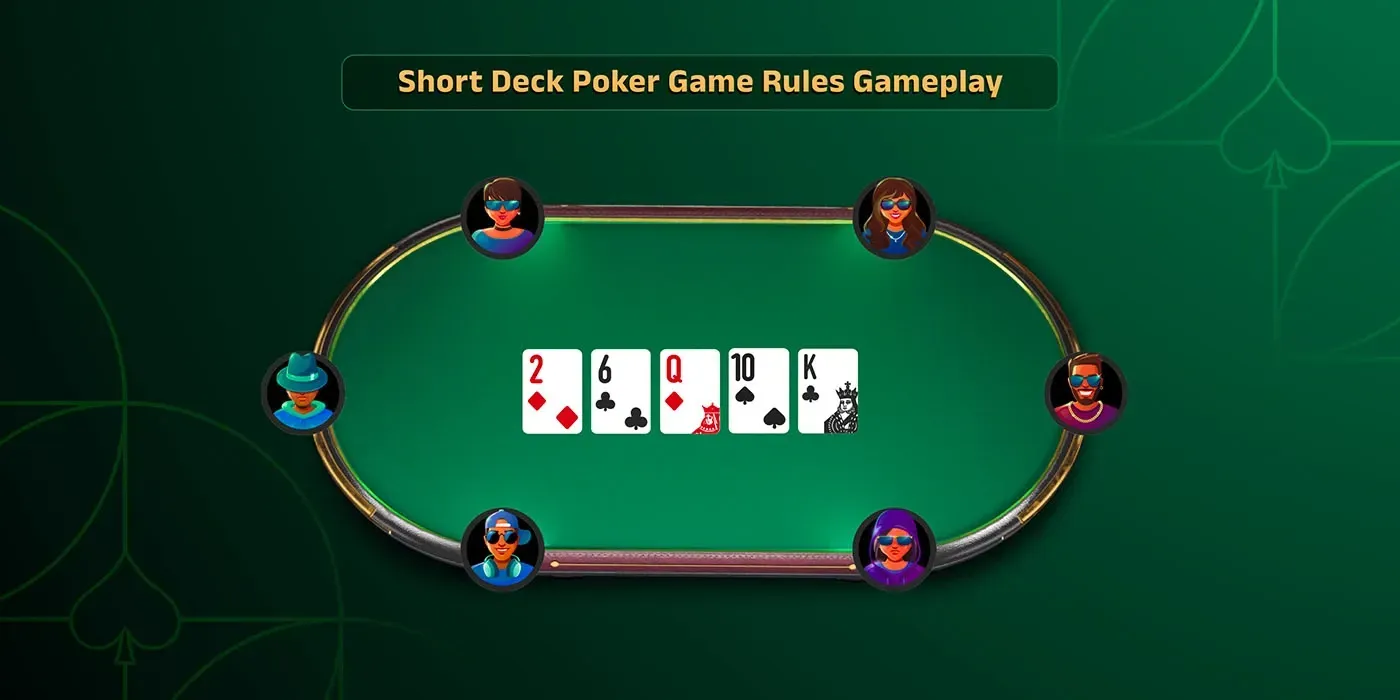- Home >
- Poker World >
- Short Deck Poker Rules: How to Play Short Deck Poker

Short Deck Poker Rules: How to Play Short Deck Poker
Short Deck Poker, often referred to as 6 Plus Hold’em, stands as an exciting and contemporary twist on the classic Texas Hold’em, having captured the fervour of poker enthusiasts globally.
Table of Contents
Within this extensive guide, we embark on a comprehensive exploration of the realm of Short Deck Poker rules. Our goal is to furnish you with a profound comprehension of this variant, addressing every facet ranging from its regulations and hand hierarchies to the pivotal distinctions setting it apart from Texas Hold’em. Upon completing this guide, you’ll possess the knowledge and confidence to navigate the exhilarating domain of Short Deck Poker rules adeptly. Let’s go into the details of what does short deck mean in poker?
How to Play Short Deck Poker
Short Deck Poker online retains the core principles of Texas Hold’em, making it accessible to players familiar with the traditional version. Here’s how the game is played:
Starting Hands: Each player is dealt two hole cards, just like in Texas Hold’em.
Community Cards: Five community cards are placed face-up in the center of the table, shared by all players.
Objective: The objective remains consistent with traditional poker: create the best possible five-card hand using a combination of your two hole cards and the five community cards.
Betting Rounds: Short Deck Poker online follows the same betting structure as Texas Hold’em, with pre-flop, flop, turn, and river betting rounds.
Winning: Players can win chips in short deck poker either by having the best hand at showdown or by using strategic betting to force opponents to fold.
Short Deck Poker Objective:
The objective in Short Deck Poker aligns with that of traditional poker – to accumulate chips by either holding the best hand at showdown or employing shrewd betting tactics that induce opponents to fold. Winning chips is the ultimate goal, and the strategies to achieve it vary greatly.
Short Deck Poker rules introduces specific variations that distinguish it from the traditional version:
Card Removal: In Short Deck Poker strategy, all cards from deuces (2s) through fives (5s) are removed from the deck. This results in a 36-card deck, fundamentally altering hand rankings and strategic considerations.
Flush Beats Full House: Unlike traditional poker, Short Deck Poker ranks a Flush higher than a Full House. This reversal can lead to unexpected outcomes during showdowns and requires players to adapt their strategies accordingly.
Versatile Aces: Aces in Short Deck Poker strategy can be used both as high cards for creating high straights (A-10-J-Q-K) and as low cards for forming low straights (A-6-7-8-9). This dual functionality adds an intriguing layer of complexity to hand evaluation.
Short Deck Poker Hand Rankings in Detail
Understanding hand rankings is pivotal in Short Deck Poker odds, given the unique deck composition. Let’s explore the hand rankings in detail, starting with the strongest:
Royal Flush:
The highest-ranking hand in Short Deck Poker odds, consisting of the A-K-Q-J-10 of the same suit. It is exceedingly rare and virtually unbeatable.
Straight Flush:
The second-strongest hand, comprising five consecutive cards of the same suit, such as 9-8-7-6-5 of hearts.
Four-of-a-kind:
Consists of four cards of the same rank, such as four kings or four sevens. It’s a potent hand that can dominate the table.
Flush:
A Flush includes five cards of the same suit, regardless of their sequential order. Importantly, it outranks a Full House in short deck poker ranges.
Full House:
It includes three cards of one rank and two cards of another rank. An example of this is three queens and two eights form a Full House in short deck poker ranges.
Three of a kind:
This hand features three cards of the same rank, such as three jacks. While strong, it can be vulnerable to higher-ranked hands.
Straight:
Comprising five consecutive cards of different suits, like 10-9-8-7-6. It’s a solid hand, but players must be cautious of higher straights in short deck poker chart.
Two pair:
Two Pair includes two sets of pairs, like two fives and two tens. It’s a respectable hand but often falls short of the top-ranked hands in short deck poker chart.
One pair:
This hand consists of a single pair of cards of the same rank, such as two queens. It’s a common hand in poker but can be beaten by higher-ranked pairs.
High card:
When no player holds a ranked hand, the highest single card in their hand determines the winner. This can lead to intriguing showdowns.
Texas Hold’em and Short Deck Poker: Key Differences
Short Deck Poker introduces substantial variations compared to traditional Texas Hold’em, significantly impacting gameplay. The key differences include:
1. Hand Value and Starting Hand Selection:
In Short Deck Poker, high cards and pairs hold greater value due to the reduced deck size.
Strong starting hands often include high cards of the same suit or pairs of higher ranks.
2. Aggressive Play:
Due to the altered hand values, players in Short Deck Poker tend to play more aggressively. This results in a faster-paced and more thrilling game, demanding quick decision-making.
3. Drawing Hands:
Drawing hands, such as flush and straight draws, become more valuable in Short Deck Poker. With fewer cards in the deck, the likelihood of completing these draws increases, enticing players to pursue them.
4. Adjustments to Post-Flop Play:
Players frequently make strategic adjustments in their post-flop play to account for the higher likelihood of opponents holding strong hands in Short Deck Poker. This involves cautious evaluation of community cards and opponent behaviours.
Conclusion
Short Deck Poker offers a thrilling and unique poker experience that challenges players to adapt their strategies according to the hand rankings and deck composition. If you are an experienced poker player or new to the game then this guide provides you with the knowledge to confidently embrace the exciting world of short deck poker hand rankings.
